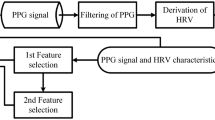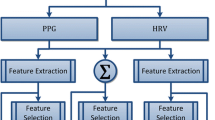Abstract
Obstructive sleep apnea is a syndrome which is characterized by the decrease in air flow or respiratory arrest depending on upper respiratory tract obstructions recurring during sleep and often observed with the decrease in the oxygen saturation. The aim of this study was to determine the connection between the respiratory arrests and the photoplethysmography (PPG) signal in obstructive sleep apnea patients. Determination of this connection is important for the suggestion of using a new signal in diagnosis of the disease. Thirty-four time-domain features were extracted from the PPG signal in the study. The relation between these features and respiratory arrests was statistically investigated. The Mann–Whitney U test was applied to reveal whether this relation was incidental or statistically significant, and 32 out of 34 features were found statistically significant. After this stage, the features of the PPG signal were classified with k-nearest neighbors classification algorithm, radial basis function neural network, probabilistic neural network, multilayer feedforward neural network (MLFFNN) and ensemble classification method. The output of the classifiers was considered as apnea and control (normal). When the classifier results were compared, the best performance was obtained with MLFFNN. Test accuracy rate is 97.07 % and kappa value is 0.93 for MLFFNN. It has been concluded with the results obtained that respiratory arrests can be recognized through the PPG signal and the PPG signal can be used for the diagnosis of OSA.







Similar content being viewed by others
References
Linz D, Linz B, Hohl M, Böhm M (2015) Atrial arrhythmogenesis in obstructive sleep apnea: therapeutic implications. Sleep Med Rev 26:87–94. doi:10.1016/j.smrv.2015.03.003
Cochen De Cock V, Benard-Serre N, Driss V et al (2015) Supine sleep and obstructive sleep apnea syndrome in Parkinson’s disease. Sleep Med 16:1497–501. doi:10.1016/j.sleep.2014.09.014
Borgström A, Nerfeldt P, Friberg D (2013) Questionnaire OSA-18 has poor validity compared to polysomnography in pediatric obstructive sleep apnea. Int J Pediatr Otorhinolaryngol 77:1864–8. doi:10.1016/j.ijporl.2013.08.030
Masa JF, Corral J, Sanchez de Cos J et al (2013) Effectiveness of three sleep apnea management alternatives. Sleep 36:1799–807. doi:10.5665/sleep.3204
Annakkaya AN, Balbay Ö, Bilgin C et al (2004) Outcomes of the eight-channel ambulatory recording unit in a sleep laboratory. Eurasian J Pulmonol 6:12–23
Bruyneel M, Ninane V (2014) Unattended home-based polysomnography for sleep disordered breathing: current concepts and perspectives. Sleep Med Rev 18:341–7. doi:10.1016/j.smrv.2013.12.002
Song C, Liu K, Zhang X et al (2015) An obstructive sleep apnea detection approach using a discriminative hidden Markov model from ECG signals. IEEE Trans Biomed Eng. doi:10.1109/TBME.2015.2498199
Kavsaoŭlu AR, Polat K, Bozkurt MR (2014) A novel feature ranking algorithm for biometric recognition with PPG signals. Comput Biol Med 49:1–14. doi:10.1016/j.compbiomed.2014.03.005
Kavsaoŭlu AR, Polat K, Muthusamy H (2015) Non-invasive prediction of hemoglobin level using machine learning techniques with the PPG signal’s characteristics features. Appl Soft Comput 37:983–991. doi:10.1016/j.asoc.2015.04.008
Karmakar C, Khandoker A, Penzel T et al (2014) Detection of respiratory arousals using photoplethysmography (PPG) signal in sleep apnea patients. IEEE J Biomed Heal Inf 18:1065–1073. doi:10.1109/JBHI.2013.2282338
Lazaro J, Gil E, Vergara JM, Laguna P (2012) OSAS detection in children by using PPG amplitude fluctuation decreases and pulse rate variability. Comput Cardiol 2012:185–188
Gaurav G, Mohanasankar S, Kumar VJ (2013) Apnea sensing using photoplethysmography. In: 2013 seventh international conference on SENS technology. IEEE, pp 285–288
Jezzini A, Ayache M, Elkhansa L, Al Abidin Ibrahim Z (2015) ECG classification for sleep apnea detection. In: 2015 international conference on advanced biomedical engineering. IEEE, pp 301–304
Berry RB, Budhiraja R, Gottlieb DJ et al (2012) Rules for scoring respiratory events in sleep: update of the 2007 AASM Manual for the Scoring of Sleep and Associated Events. Deliberations of the sleep apnea definitions task force of the American Academy of Sleep Medicine. J Clin Sleep Med 8:597–619. doi:10.5664/jcsm.2172
Siegwart DK (1995) Sleep apnoea analysis from neural network post-processing. In: 4th international conference on artificial neural networks. IEE, pp 427–432
Nazeran H, Almas A, Behbehani K et al (2001) A fuzzy inference system for detection of obstructive sleep apnea. In: 2001 conference proceedings of 23rd annual international conference of the IEEE engineering in medicine and biology society. IEEE, pp 1645–1648
Fontenla-Romero O, Guijarro-Berdiñas B, Alonso-Betanzos A, Moret-Bonillo V (2005) A new method for sleep apnea classification using wavelets and feedforward neural networks. Artif Intell Med 34:65–76. doi:10.1016/j.artmed.2004.07.014
Liu D, Pang Z, Lloyd SR (2008) A neural network method for detection of obstructive sleep apnea and narcolepsy based on pupil size and EEG. IEEE Trans Neural Netw 19:308–318. doi:10.1109/TNN.2007.908634
Tagluk ME, Akin M, Sezgin N (2010) Classification of sleep apnea by using wavelet transform and artificial neural networks. Expert Syst Appl 37:1600–1607. doi:10.1016/j.eswa.2009.06.049
Shelley KH (2007) Photoplethysmography: beyond the calculation of arterial oxygen saturation and heart rate. Anesth Analg 105:31–36
Şahan S, Polat K, Kodaz H, Güneş S (2007) A new hybrid method based on fuzzy-artificial immune system and k-nn algorithm for breast cancer diagnosis. Comput Biol Med 37:415–23. doi:10.1016/j.compbiomed.2006.05.003
Farajzadeh J, Fakheri Fard A, Lotfi S (2014) Modeling of monthly rainfall and runoff of Urmia lake basin using “feed-forward neural network” and “time series analysis” model. Water Resour Ind 7–8:38–48. doi:10.1016/j.wri.2014.10.003
Azar AT (2013) Fast neural network learning algorithms for medical applications. Neural Comput Appl 23:1019–1034. doi:10.1007/s00521-012-1026-y
Zounemat-kermani M, Kisi O, Rajaee T (2013) Performance of radial basis and LM-feed forward artificial neural networks for predicting daily watershed runoff. Appl Soft Comput 13:4633–4644. doi:10.1016/j.asoc.2013.07.007
Pérez-Godoy MD, Rivera AJ, Carmona CJ, del Jesus MJ (2014) Training algorithms for radial basis function networks to tackle learning processes with imbalanced data-sets. Appl Soft Comput 25:26–39. doi:10.1016/j.asoc.2014.09.011
Rajendra M, Shankar K (2015) Improved Complex-valued Radial Basis Function (ICRBF) neural networks on multiple crack identification. Appl Soft Comput 28:285–300. doi:10.1016/j.asoc.2014.10.044
Khamis A, Shareef H, Mohamed A, Bizkevelci E (2015) Islanding detection in a distributed generation integrated power system using phase space technique and probabilistic neural network. Neurocomputing 148:587–599. doi:10.1016/j.neucom.2014.07.004
Azar AT, El-Said SA (2012) Probabilistic neural network for breast cancer classification. Neural Comput Appl 23:1737–1751. doi:10.1007/s00521-012-1134-8
Parzen E (1962) On estimation of a probability density function and mode. Ann Math Stat 33:1065–1076
Rokach L, Schclar A, Itach E (2014) Ensemble methods for multi-label classification. Expert Syst Appl 41:7507–7523. doi:10.1016/j.eswa.2014.06.015
Wallisch P, Lusignan ME, Benayoun MD et al (2014) MATLAB for Neuroscientists. MATLAB Neurosci. doi:10.1016/B978-0-12-383836-0.00054-0
Ramachandran KM, Tsokos CP (2015) Mathematical statistics with applications in R. Math Stat with Appl R. doi:10.1016/B978-0-12-417113-8.00006-0
Azar AT, El-Metwally SM (2013) Decision tree classifiers for automated medical diagnosis. Neural Comput Appl 23:2387–2403. doi:10.1007/s00521-012-1196-7
Azar AT, El-Said SA (2014) Performance analysis of support vector machines classifiers in breast cancer mammography recognition. Neural Comput Appl 24:1163–1177. doi:10.1007/s00521-012-1324-4
Rasch D, Teuscher F, Guiard V (2007) How robust are tests for two independent samples? J Stat Plan Inference 137:2706–2720. doi:10.1016/j.jspi.2006.04.011
Alpar R (2010) Applied statistic and validation—reliability. Detay Publishing, Florida
Pan Y, Hu X, Er MJ et al (2013) Bearing condition prediction using enhanced online learning fuzzy neural networks. In: Nee AYC, Song B, Ong SK (eds) Re-engineering manufacturing for sustainability. Springer, Singapore, pp 175–182
Pan Y, Er MJ, Li X et al (2014) Machine health condition prediction via online dynamic fuzzy neural networks. Eng Appl Artif Intell 35:105–113. doi:10.1016/j.engappai.2014.05.015
Li X, Lu WF, Zhai L et al (2015) Remaining life prediction of cores based on data-driven and physical modeling methods. In: Nee AYC (ed) Handbook of manufacturing engineering and technology. Springer, London, pp 3239–3264
Torabi Jahromi A, Er MJ, Li X, Lim BS (2016) Sequential fuzzy clustering based dynamic fuzzy neural network for fault diagnosis and prognosis. Neurocomputing 196:31–41. doi:10.1016/j.neucom.2016.02.036
McCaughey EJ, McLachlan AJ, Gollee H (2014) Non-intrusive real-time breathing pattern detection and classification for automatic abdominal functional electrical stimulation. Med Eng Phys 36:1057–61. doi:10.1016/j.medengphy.2014.04.005
Acknowledgments
This research was supported by The Scientific and Technical Research Council of Turkey (TUBITAK) through The Research Support Programs Directorate (ARDEB) with project number of 115E657, and project name of “A New System for Diagnosing Obstructive Sleep Apnea Syndrome by Automatic Sleep Staging Using Photoplethysmography (PPG) Signals and Breathing Scoring” and by The Coordination Unit of Scientific Research Projects of Sakarya University. Produced from the doctoral thesis “Development of A New System for The Diagnosis of Sleep Staging and Sleep Apnea Syndrome” under the consultancy of the authors (Mehmet Recep Bozkurt), this study was supported by the SAU Commission of Scientific Research Projects (Project No.: 2014-50-02-022). The ethics committee report numbered 16214662/050.01.04/70 from Sakarya University Deanship of Faculty of Medicine, and the data use permission numbered 94556916/904/151.5815 from T.C. Ministry of Health Turkey Public Hospitals Authority Sakarya Province General Secretariat of Association of Public Hospitals were received to perform the study.
Author information
Authors and Affiliations
Corresponding author
Ethics declarations
Conflict of interest
The authors declare that they have no conflicts of interest.
Rights and permissions
About this article
Cite this article
Uçar, M.K., Bozkurt, M.R., Bilgin, C. et al. Automatic detection of respiratory arrests in OSA patients using PPG and machine learning techniques. Neural Comput & Applic 28, 2931–2945 (2017). https://doi.org/10.1007/s00521-016-2617-9
Received:
Accepted:
Published:
Issue Date:
DOI: https://doi.org/10.1007/s00521-016-2617-9




